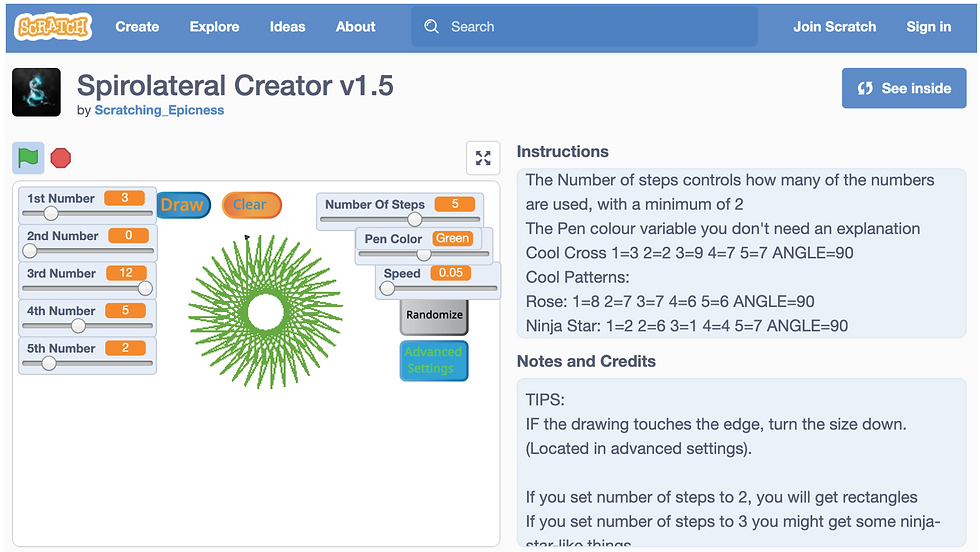IDENTIFYING THE PATTERNS OF MULTIPLICATION TABLE
Can you draw the picture of the multiplication table?
What if I tell you the images below are the multiplication table itself?

Let’s how we can create our own multiplication art!
Part I:
1. Fill in the multiplication table grid below.

2. Reduce double-digit numbers to a single digit by adding the digit of the products.
Example: If 9×9=81, add the numbers in the sum (8+1), and put the sum of 9 in the square. If the new sum is also double-digit, add those numbers. Example: 7×8=56; 5+6=11; 1+1=2. Place the number 2 in that square.

3. Assign a color to each number and fill them accordingly. For example: All number 1 boxes may be blue, number 2 boxes may be green, and so on.

4. ART: You now created one quarter of the Vedic square.
Reflect the square with respect to the vertical axis, then select both to reflect wrt the horizontal axis to complete your Vedic Square.

Even vs Odd
Tech Help:
You can use Spreadsheets like MS Excel, Numbers , Google Sheets and use Conditional Formatting to create your designs, then by using lots of different options you can create the reflections of your initial image. (The easiest is copy /paste and flip your image!)

Discussion Questions:
Historically the Vedic square was not produced on the computer, how has technology changed the way art is done and how do you think technology has affected other areas of art?
Discuss the origins of Islamic art and talk about similarities and differences in art from various cultures around the world.
Search Web to see the Vedic Art examples at art and architecture.
Part II :
Connect the Dots:
Some obvious patterns will be seen after connecting some specific numbers like; all 2’s, all 3’s, all 4’s and so on.

What patterns did you realize?
Resemblances and differences among the patterns the numbers formed?
Part III :
How to Make a Spirolateral
Spirolaterals are geometrical figures formed by the repetition of a simple rule. The pattern is formed by drawing line segments of a certain length from a number sequence with a fixed angle and a direction.

Although the spirolaterals can be created with any number sequence, we will use the Vedic Squares we have created at Part I. That’s why they are also called “VEDIC WORMS”.
1. Start with a row of numbers you choose. (1,2,3,4,5,6,7,8,9) These numbers will determine the length of each ‘step’ of the ‘spirolateral’.
2. Choose a direction; clockwise (CW) or counterclockwise (CCW)
3. Choose a grid type to draw on (In fact here, you are choosing the angle of your movement)
a. Square Grid (90 degrees )
b. Isometric Grid (60 degrees )
c. Hexagonal Grid (120 degrees ) …
4. Now start drawing spirals through your list.

For example, if we choose CW direction on a square grid with the first row of numbers,
It means 1 step up, 2 steps right, 3 steps down and 4 steps left then repeat like 5 steps up, 6 steps right, 7 steps down and 8 steps left and 9 steps up to complete your drawing.
5. Continue until you return to the start or you are convinced that your spirolateral will never return to the start.

Tech help:
Use the Polypad Canvas here to create your multiplication table Spirolaterals
Here is A 3D version of the 1-2-3-4-5-6-7-8-9 spirolateral. You can use the same Polypad canvas to create 3D Vedic spirolaterals using the other rows.

You can also use GeoGebra to draw the spirolaterals on different grids. Do not forget to select the “snap to grid” option to create accurate drawings.
Mathematical Notation:

This shape is 3 sub 36. It means, the pattern is formed by a series of 3 steps of length “1, 2, 3” with a 36˚ CW turn.
You can use any angle you wish especially if you use a computer program to make the movements easier and quicker. After the hand drawings,
try the spirolateral generator here to create your own multiplication table art.

Discussion Questions:
i. What kinds of symmetry do these shapes have?
ii. Can I predict, from the numbers in the sequence, the kind of symmetry of a spirolateral or the number of cycles in a closed spirolateral?
iii. What will happen if I use the same sequence, but always turn CW instead of CCW?
iv. What combinations of number sequence and angle of turn create non-terminating patterns?
v. If the angle of turn is 120˚, what number sequences give closed patterns?
EXTRA: Create spirolaterals by using https://scratch.mit.edu/projects/22122810/

Resources:
Weisstein, Eric W. "Spirolateral." From MathWorld--A Wolfram Web Resource. https://mathworld.wolfram.com/Spirolateral.html
Spirolateral Creator:
NCETM secondary Magazine Issue 78 https://www.ncetm.org.uk/resources/30192
Robert J. Krawczyk, THE ART OF SPIROLATERALS , College of Architecture Illinois Institute of
To read the letter that Professor Frank Odds wrote to R.J. Krawczyk about the spirolaterals that he found at 1962, please visit https://www.ncetm.org.uk/resources/30192
The original article by Frank C. Odds
ODDS, FRANK C. “SPIROLATERALS.” The Mathematics Teacher, vol. 66, no. 2, 1973, pp. 121–124. JSTOR, www.jstor.org/stable/27959201. Accessed 29 Mar. 2020.


댓글